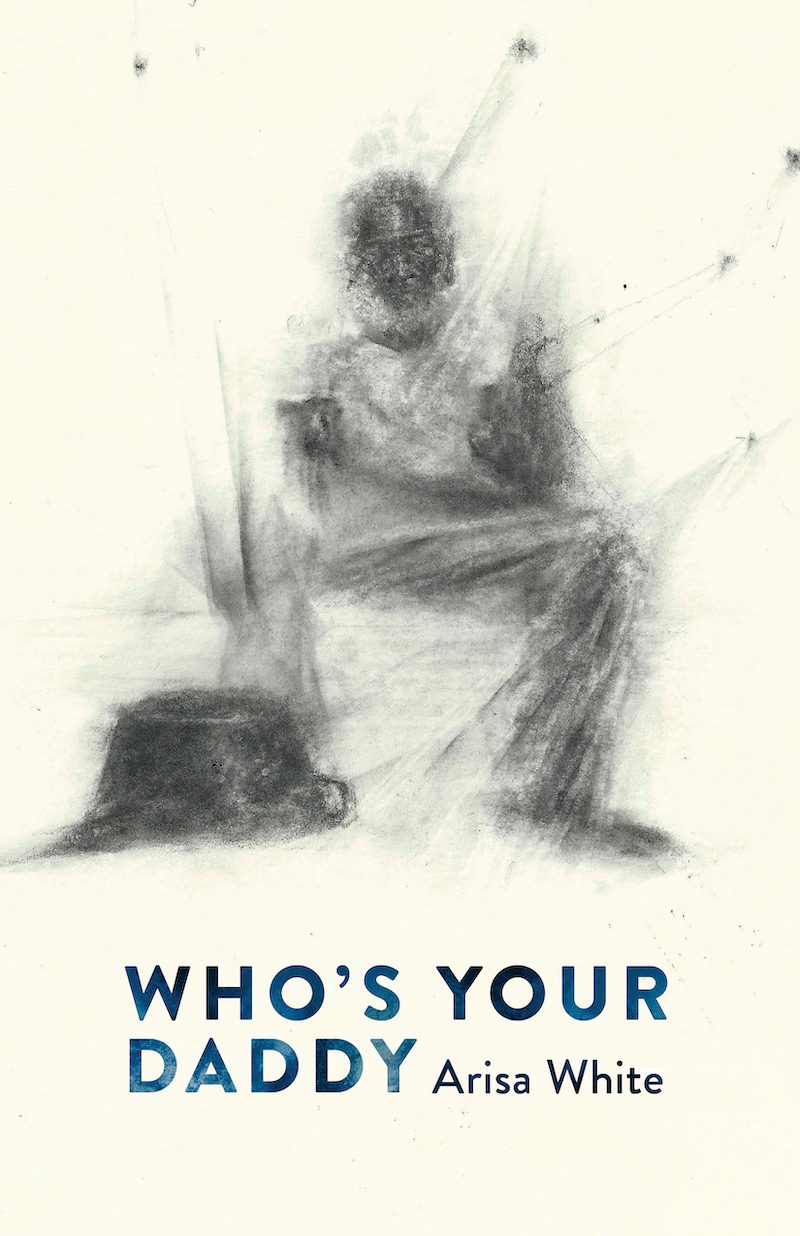We are thrilled to bring you this exclusive first look at the cover of Arisa White’s forthcoming poetic memoir, Who’s Your Daddy, out from Augury Books on March 1, 2021.
Who’s Your Daddy is a lyrical genre-bending coming-of-age tale featuring a young, queer, Black Guyanese American woman who, while seeking to define her own place in the world, negotiates an estranged relationship with her father.
Poet Terrance Hayes writes of Who’s Your Daddy that:
Arisa White channels the ear of Zora Neal Hurston, the tongue of Toni Cade Bambara, and the eye of Alice Walker in the wondrous Who’s Your Daddy. She channels Guyanese proverbs, Shango dreams, games of hide and seek, and memories of an absentee father to shape the spiritual condition. What she makes is ‘a maze that bobs and weaves a new style whenever there’s a demand to love.’ What she gives us are archives, allegories, and wholly new songs.
Below, Arisa discusses how and why she chose the cover art for Who’s Your Daddy.
***
Arisa White on selecting the cover art for Who’s Your Daddy (Augury Books, 3/1/21):
I finished up the first draft of Who’s Your Daddy in April 2018 and sent it to my editor, Kate Angus at Augury Books.
I started working on this manuscript in 2013. At first, it was a chapbook of epistolary poems called dear Gerald; then I issued a call for letters to estranged, absent, dead fathers and patriarchal figures; then, with funding from the Center for Cultural Innovation, a trip to Guyana in 2015 to meet my father.
The project was evolving, taking on a momentum of its own. I now had letters, travel notes, newspaper clippings, and citations from articles, books, and videos I came across and researched. In response to a newsletter I sent out, a few weeks after my return to the States, my undergraduate literature professor Chikwenye Okonjo Ogunyemi said that she could see books coming out of this encounter, and “Do try to write something about fathers, if you can do so without bashing them.”
In many ways, I thought going to Guyana was the culmination of this project. I’ve fulfilled my grant obligations; now I can rest. However, in that rest, Ogunyemi’s voice continued to seed ideas. By reading genre-bending work like Alexis De Veaux’s Yabo, Alexis Pauline Gumbs’s Spill, M. NourbeSe Philip’s Zong!, and Emerson Whitney’s Ghost Box, I started to imagine nuanced ways I could write Who’s Your Daddy and center the poetic in everything—it is poetic movement and its disobedience to causality that allowed me to move through space and time and affectively represent how I respond to the question of, who is your daddy?
A month after submitting the manuscript to my editor, I step into Sydney Cain’s, aka sage stargate’s, exhibition Transitions at the African American Art & Cultural Complex in San Francisco. I was taking a break from a dress rehearsal and roamed into the gallery, and “The Drinking Gourd” immediately caught my eye.
An older black man drawn in graphite, on paper, in a sitting position. What looks like a cast iron pot turned over, gossamer lines extending from his body into the sky, making the asterism of the Big Dipper, also known as the Drinking Gourd. There is an African American folk song, believed to have instructed enslaved folks to freedom, and the first verse goes like this:
Follow the drinkin’ gourd
Follow the drinkin’ gourd
For the old man is comin’ just to carry you to freedom
Follow the drinkin’ gourd
I was face-to-face with a drawing that felt like the whole experience of writing this book. A process of trying to get free from narratives that didn’t allow me to see myself clearly. The graphite captured, both texturally and emotionally, that sensation of there and not there. That palimpsestic lingering and layering. Sydney addresses her usage of these materials in an artist statement on the Carter Fine Arts Services website. She says:
These specific materials act as ciphers to assist decoding these “unseen realities.” Graphite, as the element carbon, represents the possibilities of forming into new allotropes. Chalk and carbon based material, commonly formed from the shells of ancient deep marine organisms acts as a medium of spiral time theories… Within my work, the unseen presence of the deceased become a focal point to the audience. A told story of suffering transforms into a remembrance of spiritual evolution, healing, and wisdom for people of African descent. Thus, those who have passed on have the space to become reborn as heroes again through the images thus creating a new reality.
Throughout Who’s Your Daddy, I make references to the stars, astrology, and how our beauty marks form constellations on our bodies. These patterns serve as a map and a form of connection and communication. It is how I make the distances between my father and I navigable. As the collection comes to a close, there’s a poem where I perform a healing ritual with my father by the Atlantic Ocean—my stars connect with his stars and together we make visible my grandfather’s face. My father, when he was eleven years old, didn’t get a chance to say goodbye to his father, who died unexpectedly.
I was very hesitant to write that poem, because I thought it would come off as too sentimental. However, when I saw Sydney’s piece, it was an affirmation that I went in the right direction. I could see the rebirth of my fathers’ faces in “The Drinking Gourd” and they were beautiful, tender, and loved.
***
Photograph of Arisa White by Ben Conde. Book design by Shanna Compton. Drawing on book cover: The Drinking Gourd, by Sydney Cain, aka sage stargate, graphite on paper, 2018.





